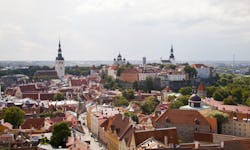Most workdays, I ride the commuter train to my office. It’s a pleasant, half-hour trip, and I almost always get to stretch out on a seat made for two. Due to my advanced senectitude, I pay half-fare; with the tax writeoff of my flexible spending account, I save even more. But here’s the kicker: I’d pay full fare if I had to.
Sure, it’s nice to be “subsidized,” but I don’t need the handout. I’d ride the rails to work just to avoid the traffic—and get a half hour to proofread copy and think.
I bring this up in the context of an interesting experiment that’s taking place in Tallinn, the capital of Estonia, where, for the last year or so, its 430,000 residents have been able to ride the city’s transit lines practically for free (there’s a €2 signup fee; tourists still pay the €1.60 fare).
According to Sulev Vedler, writing in CityScope magazine, city officals hoped to pump up ridership by 20%, cut carbon emissions, and give low-income Tallinnites greater access to job opportunities.
Tallinn, with roughly the same population as Omaha, Neb., and Raleigh, N.C., follows on the heels of Templin (Germany), Aubagne (France), and Hasselt (Belgium), all of which have tried free transit, with varying degrees of success.
In the U.S., several cities with major universities—Chapel Hill, N.C.; Minneapolis–St. Paul; Stanford, Calif.; and Corvallis, Ore.—offer free rides, as do some small communities like Commerce, Calif. (pop. 12,823), Vero Beach, Fla., (15,527), and Mason County, Wash. (60,999).
Back to Tallinn: How’s the noble experiment doing? Depends on who you ask.
The mayor of Tallinn says transit ridership is up substantially, and traffic congestion “at major crossroads” (Vedler’s phrase) is down 14%.
But researchers at Sweden’s Royal Institute of Technology who are studying Tallinn’s program say it’s more like a 3% blip in ridership, and that more than half of that can be attributed to service improvements and new bus priority lanes. In fact, the Swedish scientists found that traffic flow had not improved, as would be expected if there were fewer cars on the street.
Moreover, the Swedes reported that some Tallinnites were hopping on the tram instead of walking a few blocks—not a good prospect for the population’s future kilo count.
The researchers did, however, find that transit ridership in a high-unemployment neighborhood of Tallinn was up 10%. Whether this was helping the locals get to good jobs has not been proven.
The problem with applying the Tallinn experience to big cities in the U.S., Europe, or Asia is that Tallinn’s trams and buses were already subsidized to the tune of 70%; now it’s 96%. On most systems, fare collections pay for a huge chunk of operating costs: on my train line, it’s 50%; in London, fares cover 85% of ops costs.
If people won’t flock to transit with the lure of a free ride, what will get them on the bus? From my experience, comfort, quality of service, and convenience of schedule are, within reason, more important than low fares.
As America’s metro areas get more and more dense, our ability to move people and goods efficiently and affordably will become even more problematic. Your clients need to know that their customers will have ready access to the retail stores, offices, hospitals, schools—whatever—that you’re designing and building for them.
Until the happy day when everyone gets a free ride, though, don’t mess with my subsidies!
About the Author

Rob Cassidy
Robert Cassidy is Executive Editor of Building Design+Construction and the Editor of Multifamily Design+Construction. A city planner, he is the author of several books, including “Livable Cities,” and was a co-founder of the Friends of the Chicago River.
